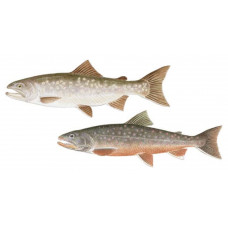Latin name
Salvelinus alpinus
Other names
Seagoing fish: char, red charr; Cree: awanans; Danish: fjeldørred; French: omble chevalier; German: saibling; Greenlandic: eqaluk; Icelandic: bleikja; Inuit: iqalugaq, iqaluk, ilkalupik, ivisaaruq, kisuajuq, majuqtuq, nutiliarjuk, situajuq, situliqtuq, tisuajuq; Japanese: iwana; Norwegian: arktisk roye, royr; Russian: goletz; Swedish: röding. Landlocked fish: blueback charr, blueback trout, Sunapee trout, golden trout (Sunapee), Quebec red.
Identification
Like all members of the genus Salvelinus, the Arctic charr has bright spots on the body, including below the lateral line, and the anterior edges of all fins on the lower body are milky white. It is a long and slender fish with a small, pointed head, a fat fin, an axillary protuberance at the base of each pelvic fin, and a slightly forked tail that looks almost square. It also has very fine scales that are so deeply embedded in the skin that they are smooth and slippery to the touch. Unlike trout, it has teeth only in the central front part of its mouth. Colouration varies greatly between marine and landlocked forms, and can even vary within individual stocks. In general, non-spawning Arctic charr are silvery with a dark green or blue tinge to the back and upper flanks and a white belly. Spawning males are bright red or reddish-orange on the sides, tail and lower fins. Their backs are muted, sometimes without a blue or green tinge, or possibly with orange or olive tones. Spawning males of some populations have a kip and some have a humped back. Spawning females are also coloured, although the red is less intense and only present on the flanks and abdomen. The back remains bluish or greenish.
Distribution
The northernmost fish, Arctic charr, has a circumpolar distribution, occurring in clear and cold rivers and lakes throughout the world, from the northeastern United States north and west through northern Canada, Alaska and the Aleutian Islands, from northern Russia south to Lake Baikal and Kamchatka, as well as Iceland, Great Britain, Scandinavia, the Alps, Spitsbergen and other places. In North America they occur from Alaska around the Bering Sea and along the Arctic coast to Baffin Island, along the coast of Hudson Bay and from the north coast of Quebec east and south to Maine and New Hampshire. With the exception of the major rivers, they rarely extend far inland. In the Northwest Territories and Nunavut, where they are most abundant, charr are found in most coastal rivers, some coastal lakes, the rivers of the High Arctic islands and some islands in Hudson Bay.
Habitat
It is represented by passerine, stream, lake-river and lacustrine forms. In oceanic life, Arctic charк remain in coastal waters. Most do not migrate far. In rivers they inhabit pools and channels. In lakes, where anadromous and land charr live, it is cold all year round, so the fish stay near the surface or in the upper layers of water, and may congregate at the mouths of tributaries when there is plenty of food.
Size
Arctic charк can live up to 30 years and grow to 3 feet in length. Sea trout grow much larger, and the world tackle record is believed to be a 32-pound, 9-ounce sea trout caught in the Three River in the Northwest Territories of Canada in 1981. In most places the sea loach weighs up to 10 pounds, with an average of 7 pounds. On land, they usually weigh a few pounds. In most waters, a sea loach weighing more than 15 pounds is considered a trophy.
Life history and Behavior
In colder regions, char spawn in September or October, or even later if they live further south. A water temperature of around 39°F is preferred. The spawning female looks for a suitable bed of gravel or rock debris. The anadromous char lives in its native river for at least 4 years before migrating to the sea for the first time. It returns to the sea between mid-August and the end of September, before the ice forms again. The larger fish return first. Unlike other salmonids, all Arctic charк leave the sea and winter in rivers and lakes, although not all spawn. Some return several times before spawning. Non-anadromous or land-locked char usually mature when they are smaller and younger. They have the same lifestyle as their anadromous counterparts.
Food and feeding habits
Insects, molluscs and small fish make up the diet of the arctic charr. Juvenile charr predominantly eats benthos (insect larvae, crustaceans) and small fish. Adults feed mainly on small fish. In some areas, ninespine sticklebacks are an important food. In winter, when the metabolic rate slows down in line with the cooling of the environment, charr often do not eat. Rather, it lives off the fat accumulated during the summer, and growth is correspondingly limited in the colder months and most intense in the sea.
Reproduction
Spawning occurs in autumn and winter. Passage, river and stream forms use semi-hilly watercourses for spawning, lake forms breed in lakes. Spawners lay eggs in rocky soil by digging nests. They reproduce more than once during their lives. In the southern parts of their range, spawning takes place annually; in the north, the interval between spawning is up to 4 years. Fecundity ranges from a few tens of eggs in brook forms to a few thousand in migratory and lake forms.
| Classification | |
| Phylum | Chordata |
| Class | Actinopterygii |
| Squad | Salmoniformes |
| Family | Salmonidae |
| Genus | Salvelinus |
| Species | S. alpinus |
| Features | |
| Conservation status | Least Concern |
| Habitat | Pelagic |
| Life span, years | 30 |
| Maximum body weight, kg | 4.5 |
| Maximum length, cm | 40 |
| Sailing speed, m/s | No information |
| Threat to people | Edible |
| Way of eating | Predator |




